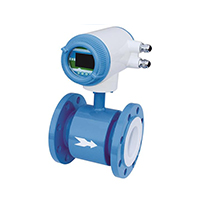Electromagnetic flowmeters are magnetically engineered flowmeters. There are no parts in this model flowmeters that prevent or restrict flow. The device isolates the electronic environment from the measurement area and provides wiring ease. Electromagnetic flowmeters adopt low frequency excitation method and multiple sensor technology. Thus, they have a 10 times more measurement scale than other flowmeters.

- Measuring Range : 0.06 – 6.36 m3 / h
- Measuring Area : Liquids
- Model : LDG
- Body Material : Aluminum Alloy
- Sensor Material : SUS304/AISI 316: Or optional: HastelloyC, HastelloyB, Titanium, Tantalum, Platinum
- Internal Coating Material : Teflon (PTFE), or Rubber
- Temperature Range -20° C / 60° C Rubber, -20 ° C/ +150° C Teflon (PTFE)
- Precision : 0.2% High Sensitivity
- Humidity Range : 5-95% RH
- Measurable Minimum Conductivity : 20 SS / cm
- Connection : Flange Connection
- Feed : 85 to 265 VAC or 24 VDC
- Protection Class : IP67, or optional IP68
- Exit : Pulse, Analog ( isolated 4-20 mA, 0-10V or Frequency), RS485, RS232C, HART Profibus and Alarm Relay Output
- Indicator : Blacklit LCD Display with 2X16 Alphanumeric Character Showing Instant and Total Flow
- Sampling Range : From 0.2 sec to 100 sec
Electromagnetic flowmeters can easily be used in all liquids with conductivity above 20 SS. Sensor selection in corrosive liquids according to different substances provides a healthy and long lasting measurement opportunity. The inner surface can be preferred as rubber or PTFE. Density adjustment, flow unit adjustment, temperature adjustment allows the device can be used in all liquids with different densities. The device menu is user-friendly and can be used for security settings with 4 different codes.
General characteristics of electromagnetic flowmeters are given below.
* Fast response time and high stability
* High precision up to 0.2%
* Double housing cavity to separate electronic part
* AC power or 24VDC supply option
* RS485; 232; HART; Profibus; MODBUS and so on. communication options
* 2-way measurement (forward (positive) measurement and reverse (negative) measurement) and NET total feature
* Analog, Frequency and Pulse output features
* Low limit and high limit alarm output features

